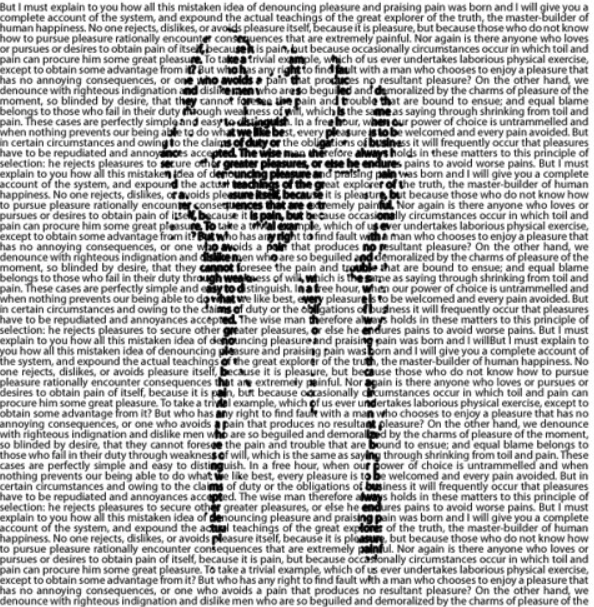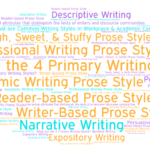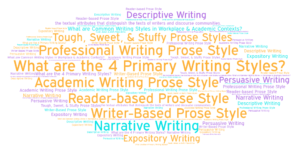
Synonyms
The terms style and voice are sometimes used synonymously. Yet style is a broader term than voice: style refers to all of the choices a writer makes when composing. For instance, style may refer to
- the way a writer uses evidence or leverages the power of visual language to strengthen the authority of their text
- how the writer establishes the currency, relevance, authority, accuracy, and purpose of the evidence and sources they cite
- whether the writer uses a deductive or inductive organization
- how the writer crafts their prose.
Voice, in contrast, refers to the writer’s personality, beliefs, and experiences, which becomes evident in their style–such as their use of figurative language, concrete, sensory language, sentence structure, diction, punctuation. Voice can be compared to a singer’s unique vocal tone and delivery, which makes their performance immediately recognizable. Just as listeners can identify a singer by their distinct sound and emotional expression, readers can discern a writer’s voice through the personality, perspective, and individual flair that imbues their work.
Related Concepts: Discourse Conventions; Discourse Community – Community of Practice; Persona; Point of View; Register; Rhetorical Analysis; Text; Tone; Voice.
What is Style?
All communicative acts are imbued with style. Even the bot that answers the phone when you call in to question your Verizon Communications bill has a style.
During deliberations on a legal matter, U.S. Supreme Court Justice Potter Stewart once remarked “I know it when I see it” to indicate what does and doesn’t constitute obscenity (Lattman 2007). Likewise, people recognize style when they see it, yet they may have trouble defining it.
Likewise, style can be challenging to concretely define. It’s a bit like like trying to catch a handful of sand—just when you think you’ve grasped it, it slips through your fingers.
- because styles of writing change as culture, technologies, and media evolve
- because a writer’s style may evolve over time as they adapt to different genres, audiences, or purposes
- because different aims of discourse, exigencies, call for different styles of writing
- because people have different perspectives on what style is or what style of writing is appropriate for a particular exigency and situation
- because the interpretation of style can be based on subjective impressions, intuitions–inklings.
- How an audience interprets style is deeply subjective. For instance, readers of books, movie goers, and art critics may disagree with one another about how to describe a character’s style.
- People may disagree with one another about whether a particular speaker’s style is appropriate for a given situation.
- The judgment of critics about a particular writer’s style may vary over time. Thanks to sociocultural, economic, and technology changes, different audiences over time are likely to have different ideas about what constitutes an appropriate or effective style.
Those reservations aside, scholars (especially in rhetoric, writing studies, and corpus linguistics) have studied style and its role in persuasion and communication. This research and scholarship has led to ten major insights about what style is and role it plays in interpretation, composing, and communication:
- Style refers five stylistic principles for exceptional writing
- Style refers to the textual and linguistic attributes of a text
- Style refers to the rhetorical aspects of a text
- Style refers to “the shape of content” (Shahn 1992)
- Style refers to the unique ways a writer expresses themselves
- Style refers to a writer’s intentional departure from convention
- Style refers to sociocultural and historical processes, including changes to the writing space
- Style refers to textual or linguistic attributes at the global or local level
- Style refers to evaluative criteria that writers, editors, teachers, and audiences use to evaluate the quality of a written work
- Style refers to an organic as opposed to a mechanical process that writers employ to make meaning and connect with their audience
1. Style refers five stylistic principles for exceptional writing
In academic writing and workplace writing, style is governed by style guides. Since the publication of William Strunk’s The Elements of Style in 1918, style guides have admonished writers to focus on five core textual attributes that are associated with writing well:
- Brevity
- Brevity refers to the art of expressing ideas concisely without sacrificing meaning. Strunk and White (2000) emphasize the importance of brevity, stating, “A sentence should contain no unnecessary words, a paragraph no unnecessary sentences” (p. 23). Zinsser (2006) also supports this idea by suggesting that “every word that serves no function, every long word that could be a short word, every adverb that carries the same meaning that’s already in the verb … these are the thousand and one adulterants that weaken the strength of a sentence” (p. 16). By focusing on brevity, writers can effectively communicate their ideas without overwhelming readers with excessive information.
- Clarity
- Clarity is the quality of being easily understood and unambiguous. Zinsser (2006) highlights the importance of clarity, asserting that “clutter is the disease of American writing” (p. 7). Strunk and White (2000) further emphasize the need for clarity by advising writers to “revise and rewrite” and “do not explain too much” (pp. 18-19). Writers should strive for clarity by avoiding jargon, convoluted sentence structures, and ambiguous language, making their message easily accessible to readers.
- Coherence
- Coherence involves organizing ideas logically and ensuring smooth transitions between them. Williams and Bizup (2016) advise writers to “create coherent paragraphs by connecting their sentences to one another” (p. 69). Strunk and White (2000) also stress the importance of coherence, stating that “the paragraph is a convenient unit; it serves all forms of literary work” (p. 28). By establishing coherence, writers can guide readers through their arguments, leading to a greater understanding of the content.
- Simplicity
- Simplicity involves expressing ideas in a straightforward manner, using clear language and avoiding unnecessary complexity. Williams and Bizup (2016) recommend that writers “prefer the specific to the general, the definite to the vague, the concrete to the abstract” (p. 44). Zinsser (2006) echoes this sentiment, stating that “the secret of good writing is to strip every sentence to its cleanest components” (p. 7). Emphasizing simplicity allows writers to convey their ideas effectively and ensures that readers can easily grasp the intended message.
- Unity
- Unity refers to the consistent focus on a single theme or idea throughout a piece of writing. According to Williams and Bizup (2016), achieving unity in a paragraph involves “focusing it on one subject or idea, signaled by a topic sentence that announces the paragraph’s main point” (p. 67). Strunk and White (2000) support this idea by stating that “a piece of writing should have a beginning, a middle, and an end, and that these parts should be easily distinguishable” (p. 28
2. Style refers to the textual and linguistic attributes of a text
Mastering the stylistic conventions of specific communities of practice is a crucial aspect of education. In U.S. postsecondary education, for instance, students encounter discipline-specific writing styles (e.g., Writing in Business; Writing in Engineering; Writing in Health Sciences). By participating in introductory or advanced courses, students acquire essential composition and stylistic conventions for their chosen professions.
When critiquing style in writing, editors and teachers tend to focus on the five stylistic principles for exceptional writing discussed above. In addition, depending on the rhetorical situation, genre, and aim of discourse, they might also consider other stylistic attributes associated with clarity in written communication, including:
- Brevity: The use of concise and precise language to convey the message efficiently and effectively.
- Clarity: The quality of being easily understood, achieved through clear expression, simple sentence structure, and precise diction.
- Cohesion and coherence: The logical organization and flow of ideas within and between sentences and paragraphs, which contribute to the clarity and overall structure of the text.
- Concrete, sensory language: The use of descriptive words that appeal to the reader’s senses, such as sight, sound, touch, taste, and smell, to create vivid and engaging imagery.
- Diction: The choice of words and phrases used in a piece of writing. Diction contributes to the formality, clarity, and tone of the text.
- Figurative language: The use of metaphors, similes, personification, and other figures of speech to create vivid imagery, express abstract ideas, or evoke emotions in the reader.
- Flow: The smooth progression of ideas, sentences, and paragraphs, creating a natural and engaging reading experience.
- Inclusivity: The use of language that respects and acknowledges diverse perspectives and experiences, avoiding biased or exclusionary expressions.
- Persona: The narrative voice or character that the writer adopts, which can shape the reader’s perception of the writer’s credibility, authority, and personality.
- Punctuation: The use of mechanics such as commas, periods, and quotation marks to impact the pacing, clarity, and tone of the writing.
- Rhythm and cadence: The pattern of stressed and unstressed syllables, as well as the flow and pacing of the text, which can create a pleasing or engaging reading experience.
- Sentence structure: The organization of words, phrases, and clauses within a sentence. Varied sentence structure, including different lengths and types of sentences, can contribute to the readability and interest of a text.
- Simplicity: The use of straightforward language and uncomplicated sentence structures to enhance clarity and ease of understanding.
- Syntax: The arrangement of words and phrases to create well-formed sentences. Syntax affects the rhythm, flow, and complexity of a text.
- Tone: The writer’s attitude or emotions conveyed through the choice of words and sentence structure. Tone can be formal, informal, serious, lighthearted, sarcastic, or any other mood or attitude.
- Unity: The logical organization of ideas and the consistency of tone and voice throughout the text, creating a cohesive and coherent reading experience.
- Voice: The unique personality and perspective of the writer that comes through in the writing. Voice encompasses elements such as tone, diction, and syntax, and helps create a distinct and recognizable style.
3. Style refers to the rhetorical aspects of a text
The determination of whether a particular style is appropriate for a particular rhetorical situation is grounded in the communication practices and conventions of particular discourse communities. As an illustration, Florida State University (FSU) fans may express their enthusiasm for a football game and demonstrate their community membership by wearing team colors, performing a warrior chopping motion, and singing the Florida State football war chant. These linguistic and nonverbal cues differentiate FSU fans from supporters of other football teams, signifying shared linguistic and semantic practices within the community.

Effective communication requires writers to adjust the style of their writing to accommodate the expectations of particular discourse communities. For instance, in school-based settings, students are expected to employ an academic writing prose style. In turn, in workplace settings, writers are expected to use a professional writing prose style.
Audience awareness is fundamental in crafting an effective message. Writers need to adapt the appropriate register, address likely counterarguments, and adopt the tone, voice, persona, and citation style expected by the target audience. This involves understanding the intended aim of the discourse, whether it is to inform, persuade, entertain, or perform another function, and tailoring the style accordingly.
To adopt a style appropriate for a global audience, writers must be mindful of cultural differences and avoid ethnocentric biases. This involves using inclusive language, considering cultural factors that might influence the audience’s interpretation of the text, and acknowledging diverse perspectives on the topic being explored. By being culturally sensitive, writers can create a more inclusive and effective message that resonates with a diverse audience.
Exigencies, or pressing issues and problems that demand attention, also influence how writers adjust their writing style. Writers should be responsive to the specific exigencies of a situation, crafting their message in a way that effectively addresses these concerns. This may involve presenting well-reasoned arguments, providing evidence to support their claims, and suggesting actionable steps that the audience can take to address the issue at hand.
A writer’s style is also shaped by their usage of rhetorical appeals, including ethos, pathos, and logos. By incorporating these appeals into their writing, writers can craft a more effective and engaging message that resonates with their intended audience:
- Establishing ethos is essential for building credibility and trustworthiness. Writers can achieve this by demonstrating their expertise, experience, and a fair-minded tone. This helps create a sense of authority, making the audience more receptive to the writer’s message.
- Employing logos involves using logical reasoning, coherent structure (e.g., deductive or inductive reasoning), and clear arguments supported by strong evidence. This is particularly important when addressing exigencies or pressing issues that demand attention. Writers should present well-reasoned arguments and offer practical solutions to effectively address these concerns.
- Pathos and fallacious pathos are useful for appealing to the emotions of the reader. Writers can use evocative language, anecdotes, or storytelling to evoke emotions and engage the audience. However, use of fallacious pathos, which may involve the inappropriate or manipulative use of emotions, may undermine the writer’s authority.
Information Literacy Perspectives and Practices are also crucial for establishing a style appropriate for academic writing and workplace writing: writers should adopt critical literacy perspectives and conventions for introducing sources, such as establishing the currency, relevance, authority, accuracy of a source. and purpose.
Writers in the social sciences and sciences understand they need to follow the formatting guidelines and citation style of the APA–Publication Manual of the APA: 7th Edition. In contrast, writers in the humanities MLA Handbook, 9th Edition:
4. Style refers to “the shape of content” (Shahn 1992)
For some writers, style and content are so interwoven that they cannot be considered separately. From this perspective, it’s an overgeneralization to say that what matters is how you say something as opposed to what you say.
In his book, The Shape of Content (1992), Ben Shahn argues that style is the “shape” content takes and it serves to give meaning to the content, transforming it from a mere collection of words or images into a work of art or communication. In other words, style is the way that content is presented to the reader, and it shapes the reader’s interpretation of that content.
Shahn believes that style is essential in any art form, including writing, and that it is what separates a great work from a mediocre one. He argues that style can transform even the most mundane or simple subject matter into something beautiful and meaningful. For Shahn, the way that content is presented is just as important as the message that it conveys.
Shahn believes that a writer’s style is not something that can be easily taught or learned. Rather, it is something that comes from within the writer, reflecting their individuality and creativity. A writer’s style is a reflection of their unique perspective on the world, and it can be influenced by a variety of factors, including their cultural background, personal experiences, artistic influences, and epistemological assumptions.
5. Style refers to the unique ways a writer expresses themselves
“Each person’s style is like his or her fingerprint or voiceprint: a unique pattern that comes from the unique person” (Elbow, 1981, p. 279)

When we write, each of us have a unique writing style that is forged in the furnace of our
- Literary, writerly history:
- Your exposure to diverse scholarly conversations on particular topics, genres of writing, and media shapes your understanding of style. By reading and writing extensively, you absorb and internalize different writing styles, ultimately forging your own unique style.
- Thought and reasoning patterns:
- The process of writing is the process of reasoning. Good writing is good thinking. Style in writing is the byproduct of analysis — especially rhetorical reasoning and logical reasoning.
- Personal beliefs:
- Your political, religious, and epistemological assumptions influence your writing, as they often shape your worldview and the themes you choose to explore.
- Language influences:
- Your home language and the language(s) you learn in school play a significant role in shaping your style. These linguistic influences bring nuances, idioms, and cultural aspects that enrich your writing and make it distinctive.
- Openness, adaptability and experimentation:
- As a writer, you may adopt different styles or personas to suit specific situations or audiences. This flexibility allows you to explore and experiment with various techniques and approaches, leading to a dynamic and versatile repertoire of styles.
While the styles of writing we employ invariably reflect our literary histories — reflecting what we’ve read and written and what we’ve learned from all of our past experiences communicating with others — we must sometimes silence or hide our unique voices. In some rhetorical situations, we must stifle our voice, our unique perspective on the matter under discussion. For example,
- in academic writing at the advanced high school level or college level and workplace writing, readers typically anticipate a focused discussion on the subject matter, rather than the writer’s personal opinions about the topic. Additionally, they expect writers to use standard written English rather than a nonstandard style.
- in school-based writing, students are expected to follow an academic writing prose style, which sometimes prohibits to a strong, personal voice
- in workplace writing, knowledge worker are use a professional writing prose style.
Those reservations aside, there are many circumstances where readers are open to your unique style, such as
- Arguments
- Autoethnography
- Autobiographies
- Blogging
- Creative nonfiction
- Editorials
- Fiction
- Journal writing
- Letters and personal correspondence
- Memoirs
- Opinion pieces
- Personal essays
- Poetry
- Short stories
- Social media content
- Testimonials
6. Style refers to a writer’s intentional departure from convention

Style can encompass a writer’s deliberate deviation from expected discourse conventions. A writer’s unique style emerges when they delve into abnormal discourse.
What is Abnormal Discourse?
Richard Rorty, a philosopher, defines abnormal discourse (aka abnormal communication) as “what happens when someone joins in the discourse who is ignorant of [the prevailing] conventions or [purposely] sets them aside” (1979, p. 320).
Individuals may diverge from convention for various reasons: They might not comprehend the audience’s expectations regarding an appropriate style for a given rhetorical situation. As artists or creative individuals, they may relish the opportunity to surprise and captivate their audience, challenging the status quo and experimenting with novel techniques. Such an approach can serve the greater goal of providing readers with fresh perspectives or fostering new understandings of a topic, event, or character.

Some literary giants, such as Virginia Woolf, James Joyce, Toni Morrison, and T.S. Eliot, have experimented with style by breaking the rules of standard written English, using convoluted syntax, or otherwise defying conventional language usage. These writers embraced a stream of consciousness style of writing, which rejects traditional punctuation conventions, evokes a sense of poetic rhythm, and adopts a voice that mimics inner speech. This innovative approach to style allows authors to create unique and groundbreaking literary works that expand the possibilities of language and expression.
Style can often be characterized by a writer or speaker’s intentional departure from convention. At times, people create new styles of expression by breaking with traditional ways of composing and communicating. To achieve their goals in a communication situation, writers may deviate from Standard Written or Spoken English. For example, writers such as Virginia Woolf, James Joyce, Toni Morrison, and T.S. Eliot employed a stream of consciousness style of writing, a style that defies traditional punctuation conventions, evokes a sense of poetic rhythm, and adopts a voice that mimics inner speech.
- Virginia Woolf, To the Lighthouse (1927):
- “Life, from being made up of little separate incidents which one lived one by one, became curled and whole like a wave which bore one up with it and threw one down with it, there, with a dash on the beach” (Woolf, 1927, p. 62).
- Cormac McCarthy, The Road (2006):
- “The blackness he woke to on those nights was sightless and impenetrable. A blackness to hurt your ears with listening. Often he had to get up. No sound but the wind in the bare and blackened trees” (McCarthy, 2006, p. 11).
- Toni Morrison, Beloved (1987):
- “124 was spiteful. Full of a baby’s venom. The women in the house knew it and so did the children” (Morrison, 1987, p. 3).

7. Style refers to sociocultural and historical processes, including changes to the writing space
Styles evolve in response to cultural, technological, and cultural changes.
In the early days, before the Internet — back when you had to find a good piece of bark to scribble your thoughts on — style was different from what it is now. Long sentences and page-long paragraphs characteristic of 19th-century writing have given way to short sentences, brief paragraphs, embedded hyperlinks, videos, and an increasing reliance on visual language.
Some stylistic changes are directly attributable to new technologies, such as Twitter or Instagram. For instance, you are likely to use a much simpler syntax and go into less depth on a topic when you post something on social media (e.g., Twitter, Instagram, Facebook) as opposed to a long-form of discourse, such as a formal report.

8. Style refers to textual or linguistic attributes at the global or local level
Style is a composite of multiple language practices that are forged at both
When analyzing your style or the style of someone else, you may find it helpful to distinguish a writer’s stylistic moves at the global versus the local level.
Teachers, bosses, critics and others may critique a document at the local, syntactical level or they may talk about the document more h at the local/sentence-level and global/rhetorical level.
| Global Perspective | Local Perspective |
| At the global level, a writer may be concerned with whether or not they’ve provided the examples and evidence their audience needs. Writers may aim to adopt a consistent purpose, persona, tone, voice, and thesis throughout a document | At the local level–sentence-by-sentence–a writer may work to avoid common sentence errors, seeking to identify problems with diction, grammar, mechanics, punctuation. They may question their word choice and check to see that they’ve used concrete & sensory language, figurative language and concise language to exemplify key points. They may copyedit documents, looking for common sentence errors. |
9. Style refers to evaluative criteria that writers, editors, teachers, and audiences use to evaluate the quality of a written work
In school-based writing, teachers tend to grade for style. Teachers notice immediately when a student’s written work fails to use
- correct grammar or mechanics
- By the conclusion of high school, students in the U.S. are expected to being able to produce prose that is relatively error free from the perspective of Standard Written English.
- lacks clarity
- uses incomprehensible language; vague language; or overgeneralizations
- fails to provide evidence for claims
- fails to provide citations for attributions
Sample Scoring Rubrics for Style
- Holistic Rubric:
- Exemplary (4 points): The writer demonstrates a unique, engaging, and consistent style throughout the text, with appropriate word choice, varied sentence structures, and a clear voice.
- Proficient (3 points): The writer’s style is generally consistent and engaging, with mostly appropriate word choice, some variety in sentence structures, and a discernible voice.
- Developing (2 points): The writer’s style is somewhat inconsistent, with occasional lapses in word choice, limited variation in sentence structures, and an unclear voice.
- Beginning (1 point): The writer’s style is inconsistent and lacks engagement, with poor word choice, monotonous sentence structures, and no discernible voice.
- Analytic Rubric:
- Word choice (1-4 points): The extent to which the writer uses precise, engaging, and appropriate vocabulary throughout the text.
- Sentence structure (1-4 points): The extent to which the writer varies sentence length and type to create interest and maintain readability.
- Voice (1-4 points): The extent to which the writer’s unique personality and perspective come through in the writing, creating a distinct and recognizable tone.
- Flow (1-4 points): The extent to which the writer creates a smooth progression of ideas, sentences, and paragraphs, leading to a cohesive and engaging reading experience.
- Six-Trait Writing Rubric:
- Ideas (1-6 points): The quality of the content and the clarity of the writer’s message.
- Organization (1-6 points): The logical structure and arrangement of ideas within the text.
- Voice (1-6 points): The unique personality and perspective of the writer as conveyed through the writing.
- Word choice (1-6 points): The precision, appropriateness, and effectiveness of the vocabulary used in the text.
- Sentence fluency (1-6 points): The flow and rhythm of the writing, including the variety and structure of sentences.
- Conventions (1-6 points): The correctness of grammar, punctuation, spelling, and formatting in the text.
10. Style refers to an organic as opposed to a mechanical process that writers employ to make meaning and connect with their audience
Style informs composing–especially the processes of reasoning and thinking. Style isn’t a mechanical process: you shouldn’t wait to think about style until you’re revising and editing. Instead, style functions as a heuristic, as way of making meaning.
Kenneth Burke (1969), a distinguished philosopher and rhetorician, highlights the organic nature of style in his work, “A Rhetoric of Motives”: “Style is an ingredient of form, a mode of the shaping or ‘forming’ process. As such, it is an integral part of the total work” (p. 61). For Burke, Burke style is not an adornment, but an essential aspect of the writer’s expression and persuasion.
In “Style: An Anti-Textbook,” Lanham (1974) emphasizes that style is an evolving and organic aspect of writing, influenced by the writer’s choices and their engagement with the text. He believes that style is central to both the writer’s identity and the connection with the reader:
- “Style, then, is not something separable from meaning; it is itself a part of meaning, the way language is used to shape reality. In this sense, style is not static but dynamic; it evolves as the writer makes choices and as the reader responds to them. And because style is such an integral part of the writing process, it is central to the writer’s identity and to the connection between the writer and the reader” (Lanham, 1974, p. 5).
Berthoff also underlines the importance of style in the process of meaning-making. For Berthoff, style functions as organic part of the writing process:
- “Style is not something static, but dynamic, not a mold or a set of rules, but the record of the writer’s choices, made in the act of composing” (Berthoff, 1981, p. 4).
- “Meaning, in other words, is discovered in the making; style is the making of meaning” (Berthoff, 1981, p. 4).
FAQs

1. Why does style matter?
In “The Elements of Style,” Strunk and White (2000) emphasize the importance of style, stating, “A writer should be concerned with style for the same reason that a golfer should be concerned with style: it affects the accuracy and force of his strokes” (p. 66). This analogy highlights the impact that style has on the effectiveness of a writer’s message. Similarly, William Zinsser, in “On Writing Well” (2006), argues that “good writing has an aliveness that keeps the reader reading from one paragraph to the next” (p. 6). He suggests that a clear and engaging style not only makes the writing more enjoyable but also helps maintain the reader’s interest.
Style matters. A lot. A writer’s or speaker’s style impacts whether readers will scan much less read and comprehend a text. Style is much more than writing grammatically correct sentences or speaking with correct diction; it’s about crafting texts that snag the reader’s attention and refuse to let go. Style is a marker of creative expression, personality, identity and community. Writers may use style to soften the blow of bad news or to make the prosaic somehow interesting. Writer’s may use appeals to pathos and ethos in order to keep the audience’s focus away from the logos of content.
Audiences may dismiss a writer or speaker’s content if they dislike or distrust that person’s style or persona. Alternatively, audiences may follow someone because they like their style. That’s why, for example, advertisers pay athletic superstars millions of dollars to endorse their products. Educated audiences, people trained in critical literacy, are likely to dismiss the authority of texts that do not follow the expected style. For instance, in school settings, teachers are likely to assign low grades to papers that do not follow adopt an academic prose style.
2. What do teachers look for when they grade for style?
The evaluative criteria teachers use to grade you work are likely to vary from assignment to assignment. However, as a first point of reference, teachers are likely to evaluate your work from the perspective of the five stylistic principles for exceptional writing:
3. How can I improve my writing style?
- First, engage in rhetorical analysis–especially audience analysis–of the rhetorical situation
To develop a style that is appropriate for a communication situation, question- How formal or informal is the situation?
- What does your audience know and feel about the topic?
- What writing style does your audience expect you to use?
- What do you want your audience to think, feel, and do?
- What genres, media, research methods, and citation styles does your audience expect you to employ?
- Engage in strategic searching. Use the open web, google scholar, and, if accessible, the gated web to check out the writing styles of other authors on the topic your exploring.
- Engage in rhetorical reasoning: Given the exigency, the call to write,
- What register and diction should you use to best accomplish your purpose in communicating?
- What rhetorical stance is appropriate?
- what register, diction, tone, voice, point of view, or persona should you aspire to develop?
- Throughout the composing process, you might try
- reading your writing out loud.
- This can be a useful way of double checking whether your tone, voice, and persona are appropriate for the communication situation.
- asking for critiques from peers, teachers, supervisors, clients about your style.
- To help your critics feel comfortable engaging in substantive critique, ask for critiques sooner rather than later and perhaps share with them your concerns about the current composition of the document.
- evaluate your own style by working through it word-by-word, line-by-line.
- experiment with one of the free or paid subscriptions for style checkers:
- ChatGPT by OpenAI ): ChatGPT is an AI language model that can help writers revise sentences, paragraphs, passages, and even entire texts. It can provide suggestions for improving clarity, conciseness, and style, while also offering creative ideas or alternative phrasings. ChatGPT offers both free access and a subscription plan called ChatGPT Plus for $20/month.
- Grammarly (https://www.grammarly.com/): Grammarly is an online writing assistant that not only checks for grammar and punctuation errors but also provides suggestions for improving writing style, clarity, and engagement. Grammarly offers a free version with basic features and a premium version with advanced style suggestions.
- Hemingway Editor (http://www.hemingwayapp.com/): The Hemingway Editor is a web-based tool that analyzes your text for readability, highlighting sentences that are too long or complex, and suggesting simpler alternatives for wordy phrases. The online version of Hemingway Editor is free to use, while the desktop app is available for a one-time fee of $19.99.
- ProWritingAid (https://prowritingaid.com/): ProWritingAid is a comprehensive writing tool that helps improve your writing by checking for grammar and spelling errors, analyzing style and readability, and providing suggestions for enhancing your text. ProWritingAid offers a free version with limited features and paid plans for more in-depth analysis and editing capabilities.
- reading your writing out loud.
Recommended Readings
Examples of Popular Style Guidelines:
Apple Style Guide
Published by Apple, this is a useful example of a company-based style guide.
A Plain English Handbook
Published by the Office of Investor Education and Assistance at the U.S. Securities and Exchange Commission, this is a useful review of copyediting guidelines.
Professional Writing Prose Style
Learn about the style of writing that characterizes the texts of professional writers.
The Elements of Style
Published by Strunk and White in 1918, The Elements of Style remains a foundational text for aspiring writers interested in style, especially punctuation and mechanics.
Examples of Research and Theory on Style
Ray, Brian. (2015). Style: An Introduction to History, Theory, Research, and Pedagogy. Parlor Press; The WAC Clearinghouse. https://wac.colostate.edu/books/referenceguides/style/
References
Elbow, P. (1981). Writing with Power: Techniques for Mastering the Writing Process. Oxford University Press.
Gipson, Walker (1966). Tough, Sweet and Stuffy: An Essay on Modern American Prose. Midland Books.
Lanham, R. A. (1974). Style: An Anti-Textbook. Yale University Press.
Lattman, Peter (September 27, 2007). “The Origins of Justice Stewart’s ‘I Know It When I See It'”. Wall Street Journal. Law Blog at The Wall Street Journal Online. Retrieved December 31, 2014.
McCarthy, C. (2006). The Road. Alfred A. Knopf.
Morrison, T. (1987). Beloved. Alfred A. Knopf.
Rorty, R. (1979). Philosophy and the mirror of nature. Princeton, NJ: Princeton University Press
Shahn, Ben (1992). The Shape of Content. Cambridge, MA: Harvard University Press.
Strunk, W. (1918). The elements of style. OCLC 781988921
Strunk, W., Jr., & White, E. B. (2000). The Elements of Style (4th ed.). Pearson.
Woolf, V. (1925). Mrs. Dalloway. Harcourt, Brace and Company.
Zinsser, W. (2006). On Writing Well: The Classic Guide to Writing Nonfiction (30th Anniversary ed.). Harper Perennial.






